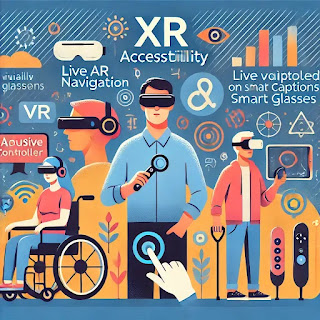Day 19: XR and Accessibility – Making Immersive Technology Inclusive for Everyone
As XR (VR, AR, and MR) continues to grow, ensuring accessibility is essential to making these technologies inclusive for all users, including those with disabilities. XR has the potential to enhance mobility, communication, and learning experiences, but it must be designed with inclusivity in mind. In today’s post, we’ll explore how XR is improving accessibility and the challenges that still need to be addressed.
1. XR for People with Visual Impairments
XR is helping individuals with low vision or blindness navigate the digital and physical worlds more effectively.
- Applications:
- AR-Assisted Navigation: Smart glasses use AI-powered object detection to describe surroundings in real time.
- Example: The Envision Glasses read text, recognize objects, and guide users with voice feedback.
- Haptic Feedback for Spatial Awareness: VR environments integrate touch-based feedback to help users "feel" their surroundings.
- Audio-Based VR: Spatial audio enhances immersion, allowing blind users to explore virtual environments through sound.
- AR-Assisted Navigation: Smart glasses use AI-powered object detection to describe surroundings in real time.
💡 Impact: XR improves independence and mobility by offering real-time navigation and interaction with digital content.
2. XR for Deaf and Hard-of-Hearing Users
Immersive technologies are enhancing communication and accessibility for people with hearing impairments.
- Applications:
- AR Live Captions: Smart glasses and mobile AR apps provide real-time subtitles for conversations.
- Example: XRAI Glasses display captions in AR, helping deaf users communicate in daily life.
- Sign Language Interpretation in XR: AI-powered avatars translate speech into sign language within VR/AR environments.
- Haptic Alerts for VR Experiences: Vibrational feedback signals in VR help deaf users stay aware of key interactions.
- AR Live Captions: Smart glasses and mobile AR apps provide real-time subtitles for conversations.
💡 Impact: XR helps bridge communication barriers, making digital and real-world interactions more accessible.
3. XR for Users with Mobility Challenges
For individuals with physical disabilities, XR can enhance movement, rehabilitation, and accessibility in digital spaces.
- Applications:
- VR Physical Therapy: Motion-based VR games assist with rehabilitation for stroke patients and individuals with motor impairments.
- Example: NeuroRehab VR offers adaptive therapy using VR for recovery exercises.
- Voice-Controlled XR Navigation: Users with limited mobility can interact with XR environments through voice commands instead of hand gestures.
- Adaptive XR Controllers: Specialized controllers and eye-tracking technology enable hands-free navigation in VR/AR.
- VR Physical Therapy: Motion-based VR games assist with rehabilitation for stroke patients and individuals with motor impairments.
💡 Impact: XR provides new ways to interact with digital environments, improving mobility and rehabilitation experiences.
4. Inclusive XR Learning Environments
XR is making education more accessible by providing customizable learning experiences for diverse needs.
- Applications:
- Dyslexia-Friendly AR Learning Tools: AR apps adapt text readability and convert words into speech.
- Autism Support with XR: VR social training environments help autistic individuals practice real-world interactions.
- Example: The Floreo VR app helps children with autism develop social and communication skills.
- Multi-Sensory Learning: XR blends visual, auditory, and haptic feedback to accommodate different learning styles.
💡 Impact: XR is personalizing education, ensuring that every learner, regardless of ability, can engage with content effectively.
5. Challenges to XR Accessibility
While XR offers promising accessibility solutions, several challenges remain:
- Hardware Limitations: Many XR devices are not designed with accessibility features in mind.
- Affordability: High costs limit access to adaptive XR tools for people with disabilities.
- Standardization Issues: There is no universal accessibility standard for XR interfaces.
💡 Future Solutions:
- Design XR hardware with built-in accessibility features.
- Develop affordable, mobile-friendly XR accessibility apps.
- Create industry-wide accessibility guidelines for XR developers.
Why XR Accessibility Matters
Making XR accessible ensures that everyone, regardless of ability, can benefit from immersive technology. By designing XR experiences with inclusivity in mind, we create a more connected, equitable, and engaging digital future for all.
What’s Next?
In tomorrow’s post, we’ll explore the ethics of XR, discussing privacy, security, and responsible development in immersive technologies. Stay tuned!
